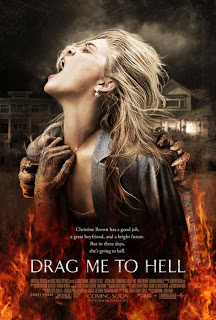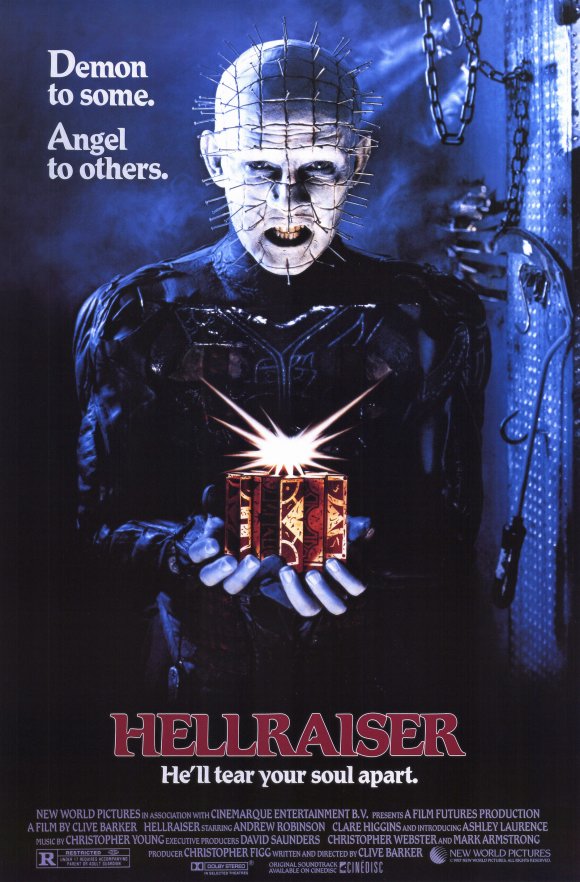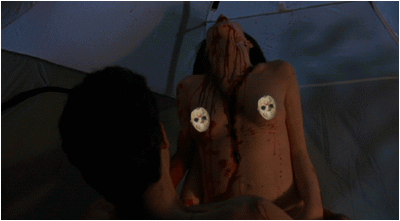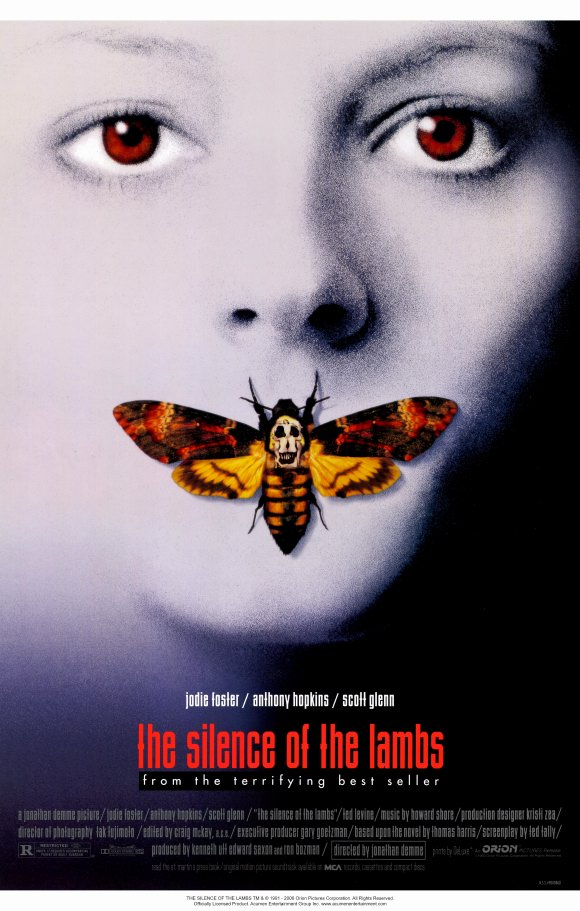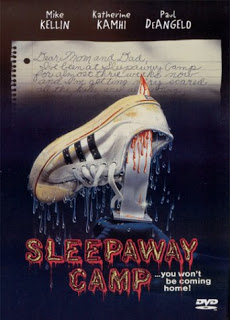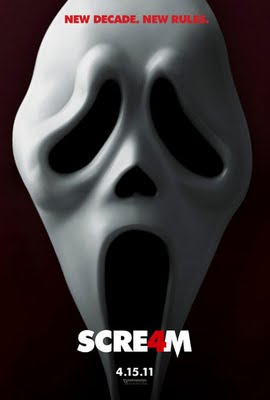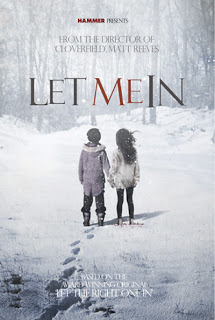This review, written by Stephanie Rogers, was originally published in June 2009.
But, I ask you, can a film that sacrifices a goat and a kitten really be taking itself so seriously?
 Everything that exists in this movie is a stereotype: the skinny blonde who used to be fat and now refuses to eat carbs, the skinny blonde’s self-hatred and rejection of her farm-girl roots, the rich boyfriend who will undoubtedly help her escape it all, his rich and consequently vapid, overbearing parents who want their son to marry a nice upper-class girl, the patriarchal workplace where the skinny blonde gets sent for sandwiches by her male coworkers, the jerk who sells out a coworker in order to get promoted, the brown-skinned psychics who hold hands around a table and chant in an attempt to invoke The Evil Spirit, the gypsy, obviously, and not least importantly, the fucking goat sacrifice.
Everything that exists in this movie is a stereotype: the skinny blonde who used to be fat and now refuses to eat carbs, the skinny blonde’s self-hatred and rejection of her farm-girl roots, the rich boyfriend who will undoubtedly help her escape it all, his rich and consequently vapid, overbearing parents who want their son to marry a nice upper-class girl, the patriarchal workplace where the skinny blonde gets sent for sandwiches by her male coworkers, the jerk who sells out a coworker in order to get promoted, the brown-skinned psychics who hold hands around a table and chant in an attempt to invoke The Evil Spirit, the gypsy, obviously, and not least importantly, the fucking goat sacrifice.
The point is: it’s hard to play the I-hated-this-movie-because-of-the-blah-blah-“insert offensive stereotype”-game, when the film unapologetically turns everyone into a caricature.
Drag Me To Hell is about a young woman, Christine (played by Alison Lohman), who makes a questionable decision in an effort to get promoted at the bank where she works. She refuses to give a third extension on a woman’s mortgage loan, and in doing so, the woman, Mrs. Sylvia Ganush (played by Lorna Raver), could potentially lose her home. The twist? Christine could’ve given her the extension. But she chose not to. Instead, Christine wanted to prove to her boss that she’s a tough, hard-nosed, business savvy go-getter, and therefore certainly more qualified than her ass-kissing male coworker (who she’s in the process of, ahem, training) to take over the assistant manager position.
Then, as luck would have it, all hell breaks loose.
 For the next hour and a half, these women go all testosterone and maniacally kick each other’s asses. This isn’t an Obsessed-type ass-kicking, where Beyonce Knowles beats the crap out of Ali Larter over, gasp, a man! and where all that girl-on-girl action plays like late-night Cinemax porn for all the men in the house. (Read Sady Doyle’s excellent review of it here). No, this is strictly about two women, one old, gross, and dead, the other young, gorgeous, and alive, trying to settle a score. Christine wants to live, dammit! And Mrs. Ganush wants to teach Christine a lesson for betraying her in favor of corporate success!
For the next hour and a half, these women go all testosterone and maniacally kick each other’s asses. This isn’t an Obsessed-type ass-kicking, where Beyonce Knowles beats the crap out of Ali Larter over, gasp, a man! and where all that girl-on-girl action plays like late-night Cinemax porn for all the men in the house. (Read Sady Doyle’s excellent review of it here). No, this is strictly about two women, one old, gross, and dead, the other young, gorgeous, and alive, trying to settle a score. Christine wants to live, dammit! And Mrs. Ganush wants to teach Christine a lesson for betraying her in favor of corporate success!
I vacillated between these two women throughout the movie, hating one and loving the other. After all, Christine merely made a decision to advance her career, a decision that a man in her position wouldn’t have had to face (because he wouldn’t have been expected to prove his lack of “weakness”). If her male coworker had given the mortgage extension, I doubt it would’ve necessarily been seen as a weak move. And even though Christine made a convincing argument to her boss for why the bank could help the woman (demonstrating her business awareness in the process), her boss still desired to see Christine lay the smack-down on Grandma Ganush. I sympathized with her predicament on one hand, and on the other, I found her extremely unlikable and ultimately “weak” for denying the loan. (Check out the review at Feministing for another take on this.)
Mrs. Ganush, though, isn’t your usual villain. She’s a poor grandmother, who fears losing her home. She literally gets down on her knees and begs Christine for the extension. Sure, she hacks snot into a hankie and gratuitously removes her teeth here and there, but hey, she’s a grandma, what’s not to love? Other than, you know, evil.
 I love that this movie is about two women who are both arguably unlikeable to the point where you hope they either both win or both die. (The last time I remember feeling that way while watching a movie was probably during some male-driven cop/gangster drama. Donnie Brasco? American Gangster? Goodfellas? Do women even exist in those movies?) Everyone else is a sidekick, including the doe-eyed boyfriend (played by Justin Long), who basically plays the stand-by-your-(wo)man character usually reserved for women in every other movie ever made in the history of movies, give or take, like, three.
I love that this movie is about two women who are both arguably unlikeable to the point where you hope they either both win or both die. (The last time I remember feeling that way while watching a movie was probably during some male-driven cop/gangster drama. Donnie Brasco? American Gangster? Goodfellas? Do women even exist in those movies?) Everyone else is a sidekick, including the doe-eyed boyfriend (played by Justin Long), who basically plays the stand-by-your-(wo)man character usually reserved for women in every other movie ever made in the history of movies, give or take, like, three.
But at the same time, one could certainly argue that Christine’s unwillingness to help Mrs. Ganush, which results in Christine spending the next three days of her life desperately trying not to be dragged to hell, plays as a lesson to women: you can’t get ahead, regardless, so just stop trying. (Dana Stevens provides an analysis on Slate regarding this double-edged-sword dilemma that Christina finds herself in.)
 Some have also argued that Drag Me To Hell exists in the same vein as the Saw films: it’s nothing but torture porn and obviously antifeminist. Yes, it’s gory, with lots of nasty stuff going in and out of mouths (Freud?), but the villain gets her share, and Christine hardly compares to the traditional heroine of lesser gore-fests: for one, she’s strong, much stronger than the horror-girls who can’t seem to walk without falling down in their miniskirts, and for the most part, she makes life-or-death decisions on her own, growing stronger and more adept as she faces the consequences of those decisions.
Some have also argued that Drag Me To Hell exists in the same vein as the Saw films: it’s nothing but torture porn and obviously antifeminist. Yes, it’s gory, with lots of nasty stuff going in and out of mouths (Freud?), but the villain gets her share, and Christine hardly compares to the traditional heroine of lesser gore-fests: for one, she’s strong, much stronger than the horror-girls who can’t seem to walk without falling down in their miniskirts, and for the most part, she makes life-or-death decisions on her own, growing stronger and more adept as she faces the consequences of those decisions.
Perhaps most importantly, Christine isn’t captured by some sociopathic male serial killer and helplessly tortured in a middle-of-nowhere shed for five days. She trades blows with her attacker, and at one point, in pursuit of Mrs. Ganush, she even states that she’s about to go, “Get some.” (Ha.)
I personally read the film as an attempt to uphold the qualities our society traditionally categorizes as “feminine” characteristics: compassion, understanding, consideration, etc. I’m not suggesting that men don’t also exhibit these qualities, but when they do, they’re often considered weak and unmanly, especially when portrayed on-screen, which is demonstrated quite effectively when Christine confronts her male coworker about his attempts to sabotage her career; he bursts into tears in a deliberately pathetic played-for-laughs diner scene.
But it’s only when Christine rejects these qualities in herself (the sympathetic emotions she initially feels toward Mrs. Ganush), and consciously coaxes herself into adopting hard-nosed, traditionally “masculine” characteristics (which her male boss rewards her for), that she’s ultimately punished—and by another woman, no less. The question remains, though, is she punished for being a domineering corporate bitch, or is she punished for rejecting her initial response to help out? Regardless of the answer, the film makes a direct commentary on the can’t-win plight of women in the workplace, and, newsflash: it still ain’t pretty.
Watch the trailer here.
